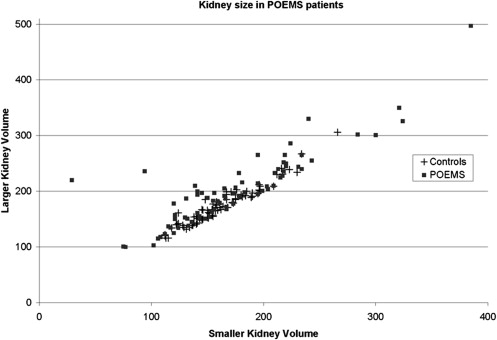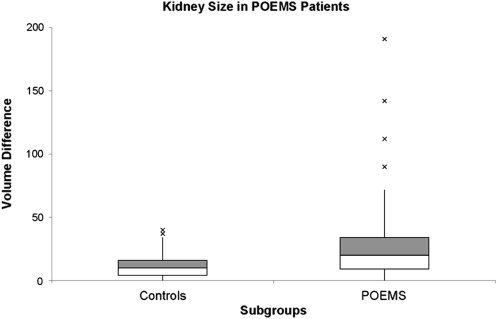Rationale and Objectives
Organomegaly in POEMS syndrome generally refers to the liver, spleen, and lymph nodes. This study investigates whether there is a significant difference in kidney sizes in patients with POEMS compared to normal controls.
Materials and Methods
Calculated kidney volumes from 77 patients with POEMS syndrome who had undergone imaging by computed tomography or magnetic resonance imaging were compared to frequency-matched controls. For the POEMS patients and the controls, the volume of each kidney was obtained from a three-dimensional segmentation algorithm. Univariate and multiple variable linear regression models were used to identify any differences in kidney size between normal and POEMS patients.
Results
There was a univariate statistically significant association between disease state and the difference in kidney volume; having POEMS was associated with 16.3 cm 3 greater kidney volume difference compared to control patients, P < .001. Using a multiple variable model and after adjusting for age, sex, and the smaller kidney size, there was a statistically significant association between disease state and the difference in kidney volume; having POEMS was associated with 16.8 cm 3 greater kidney volume compared to control patients, P < .001. There was not an independent statistically significant association between age, sex, or volume of the smaller kidney and the difference in kidney volume.
Conclusion
This confirms what is known or suspected clinically, that organomegaly in POEMS includes renomegaly.
POEMS syndrome, sometimes referred to as Crow-Fukase syndrome and Takatsuki syndrome, is a rare multisystem disorder with the dominant clinical feature of chronic progressive sensorimotor polyneuropathy. Bardwick et al first used the acronym, POEMS, in 1980 to describe important features of the syndrome: polyneuropathy (P), organomegaly (O), endocrinopathy (E), M-protein (M), and skin changes (S) . Other characteristics of this disorder, not included in the acronym, include sclerotic bone lesions, Castleman disease, edema, papilledema, pleural effusion, ascites, thrombocytosis, polycythemia, fatigue, clubbing, peripheral neuropathy, monoclonal plasma cell dyscrasia, and elevated vascular endothelial growth factor levels . The peak incidence of POEMS occurs in the fifth and sixth decades (median age, 51 years) .
Organomegaly typically characterized by hepatomegaly, splenomegaly, and lymphadenopathy or Castleman disease is a common feature of POEMS syndrome with an incidence of 50% in one large case series . Results of our exhaustive literature search of variations in renal size associated with POEMS yielded two reports of bilateral renal enlargement , four cases of bilateral renal contraction in a case series of 52 patients, and two cases of unilateral renal contraction from the same series .
Get Radiology Tree app to read full this article<
Materials and methods
Get Radiology Tree app to read full this article<
Get Radiology Tree app to read full this article<
Get Radiology Tree app to read full this article<
Get Radiology Tree app to read full this article<
Results
Get Radiology Tree app to read full this article<
Get Radiology Tree app to read full this article<
Table 1
Calculated Kidney Volumes and Volume Differences
Open full size image
Table 2
Models of Difference in Kidney Volume (Larger-smaller, cm 3 )
Univariate Multiple variable Covariate Estimate (cm 3 )P Value Estimate (cm 3 )P Value Age (+10 y) 2.4 .17 0.3 .89 Age ≥45 y 5.6 .22 — — Female gender −3.4 .44 −5.9 .20 Body surface area (+0.1) −0.8 .38 — — Body mass index (+5) −3.3 .11 — — POEMS 16.3 <.001 16.9 <.001 Smaller kidney volume (+100 cm 3 ) −1.4 .74 −5.9 .20
The univariate values for age, gender, body size measures, and smaller kidney volume were not clinically significant. The disease state of POEMS is associated with a 16 cm 3 greater kidney volume compared to controls ( P < .001) on univariate analysis, and 17 cm 3 greater kidney volume compared to controls ( P < .001) on multiple variable analysis.
Get Radiology Tree app to read full this article<
Discussion
Get Radiology Tree app to read full this article<
Get Radiology Tree app to read full this article<
Get Radiology Tree app to read full this article<
Get Radiology Tree app to read full this article<
References
1. Bardwick P.A., Zvaifler N.J., Gill G.N., et. al.: Plasma cell dyscrasia with polyneuropathy, organomegaly, endocrinopathy, M protein, and skin changes: the POEMS syndrome. Report on two cases and a review of the literature. Medicine (Balt) 1980; 59: pp. 311-322.
2. Dispenzieri A.: POEMS syndrome. Blood Rev 2007; 21: pp. 285-299.
3. Dispenzieri A., Kyle R.A., Lacy M.Q., et. al.: POEMS syndrome: definitions and long-term outcome. Blood 2003; 101: pp. 2496-2506.
4. Soubrier M., Sauron C., Souweine B., et. al.: Growth factors and proinflammatory cytokines in the renal involvement of POEMS syndrome. Am J Kidney Dis 1999; 34: pp. 633-638.
5. Arenson A.M., Rubenstein J.D., McKee J.D.: Renal ultrasound in POEMS syndrome. J Clin Ultrasound 1985; 13: pp. 208-209.
6. Fam A.G., Rubenstein J.D., Cowan D.H.: POEMS syndrome. Study of a patient with proteinuria, microangiopathic glomerulopathy, and renal enlargement. Arthritis Rheum 1986; 29: pp. 233-241.
7. Mizuiri S., Mitsuo K., Sakai K., et. al.: Renal involvement in POEMS syndrome. Nephron 1991; 59: pp. 153-156.
8. Nakamoto Y., Imai H., Yasuda T., et. al.: A spectrum of clinicopathological features of nephropathy associated with POEMS syndrome. Nephrol Dial Transplant 1999; 14: pp. 2370-2378.
9. Cheong B., Muthupillai R., Rubin M., et. al.: Normal values for renal length and volume as measured by magnetic resonance imaging. Clin J Am Soc Nephrol 2007; 2: pp. 38-45.
10. Kang K., Lee Y., Park S., et. al.: A comparative study of methods of estimating kidney length in kidney transplantation donors. Nephrol Dial Transplant 2007; 22: pp. 2322-2327.

